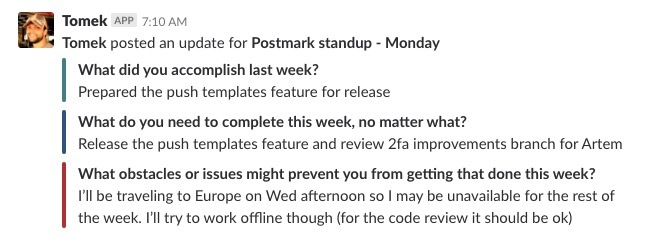As with many distributed teams, our approach to tools at Postmark is to try to strike a balance between making sure everyone on the team knows what’s going on, and not having hours of meetings every day. Since we focus on optimizing asynchronous communication, we haven’t done daily in-person stand-ups for a while, instead opting for weekly check-ins with our small (3-4 person) project teams on Mondays to plan out the week ahead.
The problem is that with only one team meeting a week, it’s hard to respond to issues quickly when they come up. If a team member is having a problem, or we didn’t realize before that two projects are related somehow, it could take up to a week to find out about the issues. So we wanted a lightweight, useful, and more frequent way to check in with each other as a whole team. We also didn’t want this to be just an update for everyone else. We wanted to make it a useful planning tool for individual work as well.
So we started looking for stand-up bots built for Slack, and of course, there are tons of them. We ended up signing up for Geekbot because it met our most important criteria: It’s asynchronous and very flexible. We set up Geekbot to ask each team member (product, design, engineering, and QA—we’re all in this) a set of questions at 9 am in their time zone (team members can also adjust this time if they’d like to receive the questions earlier or later in the day). It means each team member can use these questions to be thoughtful about their days and what they want to accomplish.
To make this more useful for us, we also evaluated the traditional “stand-up” questions. Through trial and error, we changed it up to make this much more of a planning and assistance tool than a “tell us what you’re doing” tool. On Mondays we ask these questions:
What did you accomplish last week?
What do you need to complete this week, no matter what?
What obstacles or issues might prevent you from getting that done this week?
And on Tuesdays through Thursdays (4-day work weeks!) we adjust these slightly:
What did you accomplish yesterday?
What is on your plate today to support this week's goal?
Do you feel that you will reach this week’s goal? If not, what obstacles or issues might prevent you from getting it done?
Instead of just listing out the things we do, these questions allow us to tell each other if something happened that distracted us from the work we wanted to do, which helps us solve those issues as they come up. So here’s an example of what our Geekbot responses looks like on a Monday:

Every time someone answers these questions, Geekbot posts a status in our #pm-standup team room in Slack, where we can all read through it on our own time.
There is nothing groundbreaking about what we’re doing here, but I wanted to write up our process because I know many distributed teams struggle with this. The issue is always the same:
How do we make stand-ups useful so they don’t feel like busywork that distracts from the jobs we should be doing?
By using an asynchronous bot and adapting the questions to our needs, we accomplished a few important things:
- Every member on the team takes a few minutes every morning to plan out their day, and troubleshoot anything that might have gone wrong the previous day.
- Instead of weekly meetings that are an hour long where we discuss what everyone is working on, we can have focused 30-minute sessions in our project teams every Monday where we solve problems and address issues that came up during the week.
- With more frequent updates and a higher signal to noise ratio, I am much more equipped to fulfill my role as product manager.
So even if your remote team is against the idea of a stand-up, I recommend you try something like this. Don’t just do what we did though. Choose your own questions, your own cadence, maybe even your own tool. But do something—start with the question “How can we make frequent check-ins useful?” and see what the team comes up with.

